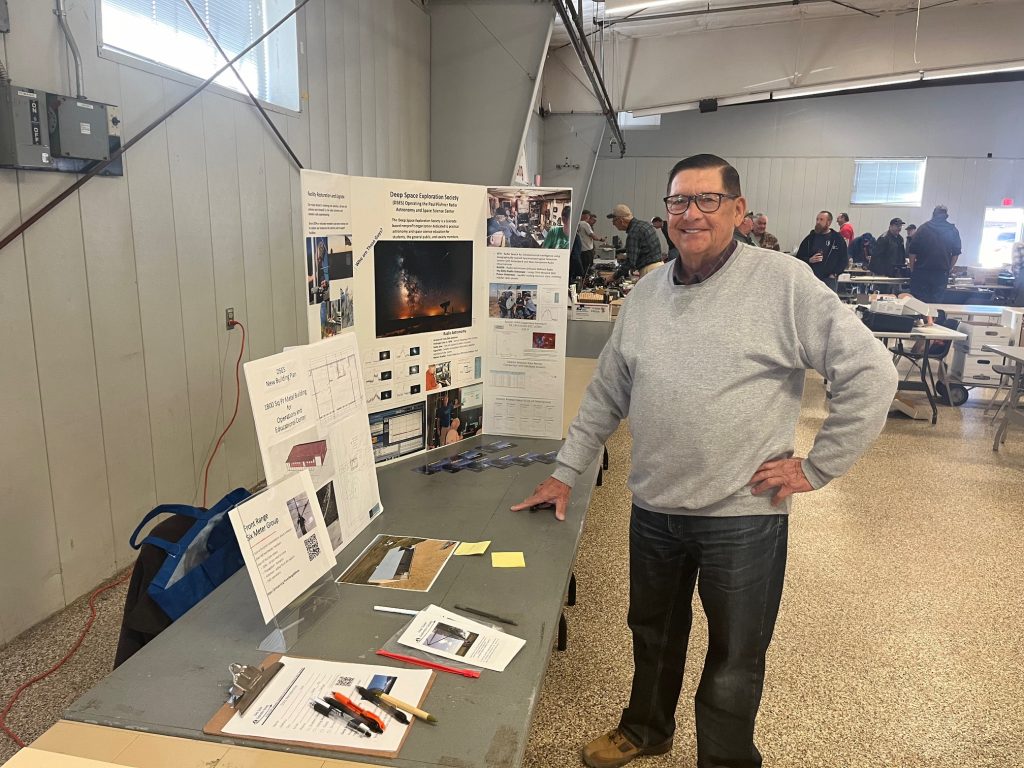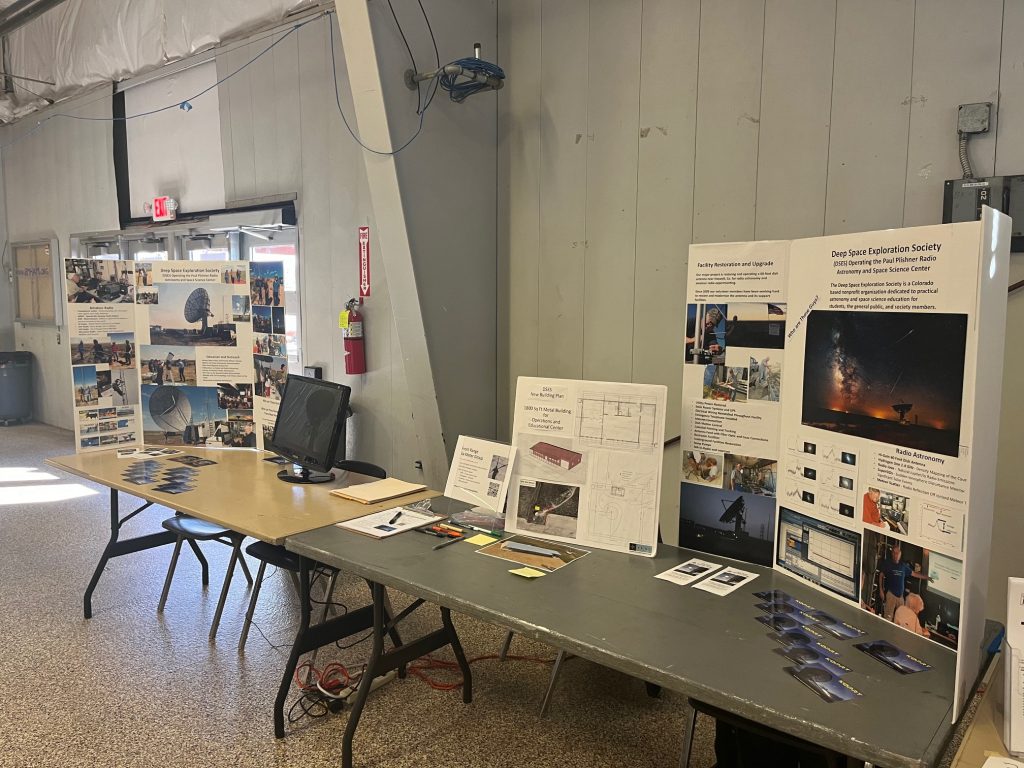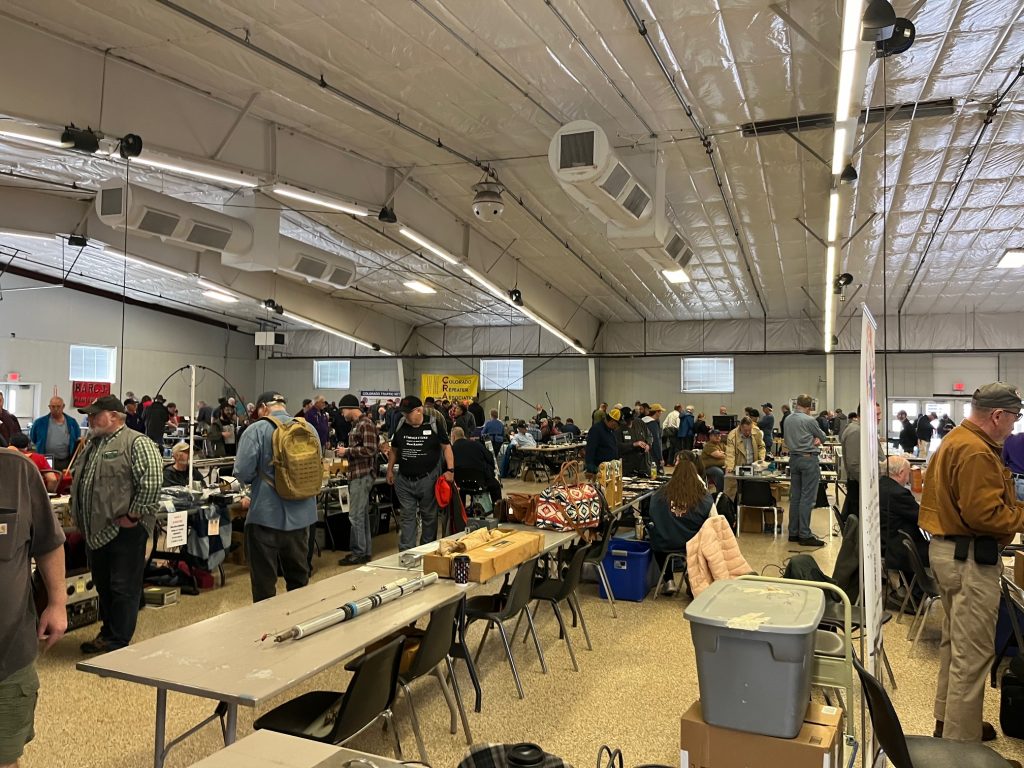This year’s Open House will be held on September 27th. Once again, we will be able to bounce signals off the moon during the event. There will also be a BBQ lunch fund raiser for the local High School. See the full details of the event: DSES 2025 Open House
Category: Education
Local Community Event
In a recent initiative aimed at strengthening community ties, Rob McMasters, a valued Deep Space Exploration Society (DSES) member with roots in Las Animas and now residing in Idaho, organized a noteworthy event on Saturday, April 26th, 2025, following the Friday Santa Fe Trails Days celebration. This gathering was specifically designed for educators and interested individuals from neighboring communities, many of whom Rob has longstanding connections with from his upbringing.
Read a report by Bill Miller DSES VP on the event here: Local Event


Earth-Venus-Earth 2025 Report
Paul Sobon, DSES President and EVE25 project manager, has written a report covering all aspects of this project. The EVE experiment was conducted on March 22, 2025.
Read the report here: EVE25 Report
Update: ORI has provided their detailed link budget analysis here: Link Budget

EVE 25 Control Room

EVE25 Main Assembly
2025 Science Fair Awards
Bill Miller provided this report on the DSES team judging at the Pike Peak Regional Science and Engineering Fair:
On Saturday, February 22nd the DSES team consisting of Barb McAllister, Roger Oakey, Bill Thomas, and Bill Miller participate as special awards judges for the Pike Peak Regional Science and Engineering Fair.
We judged the senior and junior projects by splitting them into two-person teams. For time savings with so many projects to cover, we tried to judge only those projects that had some relevant aspect to what we do in our society involving, space science, radio, computers, engineering, energy, and other technically relevant areas.
For the full report click here: 2025 Science Fair.
Las Animas High School Visit
Doug Leber provided the following report on the recent Las Animas High School Visit to the DSES site:
The Deep Space Exploration Society (DSES) hosted its first high school field trip on Wednesday, January 22, 2025, when seventeen Las Animas High School students and three staff members toured the Plishner Radio Astronomy and Space Sciences Center outside Haswell, CO. About half the students will participate in this year’s Colorado Science Olympiad competition. Jennifer Pointon, Science Olympiad coach, and Las Animas High School counselor, said she wanted students to see the Plishner facilities and learn how DSES can provide opportunities for research and mentorship in astronomy, radio, electronics, and engineering. Joshua Japhet (Las Animas HS Dean of Students and Science teacher) and Cody Hines (Las Animas HS Instructional Coach) also helped make this visit successful.
Bill Miller, DSES Vice President, gave an overview of the organization’s history and the years of effort required to revive the 60-foot-diameter radio telescope at the Haswell site. He introduced radio astronomy and some of the studies DSES members have conducted since restoring the telescope, including detecting pulsars and masers, observing solar and planetary radio emissions, and mapping the hydrogen line to show which galaxies are moving toward or away from Earth.
DSES Board member Ray Uberecken and DSES member Roger Oakey showed students how we control the dish to track and focus on deep space objects as Earth revolves. Mr. Japhet said students enjoyed watching how the huge dish moved. Mr. Uberecken also showed different ways radio frequency signals are represented, using an oscilloscope to show a signal’s waveform in real-time (the frequency and shape of an electrical signal) and the same signal in a waterfall display, which shows its intensity and relationship to other signals nearby on the radio spectrum.
Students then braved the intense winds and cold to venture to the bunker location of the DSES amateur radio station, where Board member Paul Sobon demonstrated how long-distance contacts are made using high-frequency (HF) transceivers. Under his supervision, several students learned to call ‘CQ,’ the amateur radio shorthand for “I’m here and ready to take your call!” Unfortunately, because band conditions were poor, no student got a response. Later, Paul Sobon reached a radio amateur in the Canary Islands, and students observed two-way HF radio communication between stations over 5,000 miles apart.
Since 2009, society members have devoted hundreds of hours to rebuilding the Plishner site. In 2023, a grant from Amateur Radio Digital Communications (ARDC) provided funds to complete a new building suitable for hosting groups.
DSES President Myron Babcock noted that this field trip visit to the Plishner Radio Astronomy and Space Sciences Center reflected the dreams of Michael Lowe, former Board DSES Board President, who sought to create a center for radio astronomy and space science education in Southeast Colorado. Over the next year, DSES hopes to host more school trips to the Plishner Center and work with area middle- and high-school students to advance their studies in science and radio.
If you are a parent, teacher, or school representative interested in learning more about DSES and how the society can support your students, please contact Doug Leber, the DSES education outreach coordinator.

Open House 2024 Report
Bill Miller, DSES VP, has written a great report on the DSES Open House that was held on October 5, 2024. It was a very successful event with over 100 attendees enjoying the new building and other activities.
Click here for the report: 2024 Open House.
There is also a video provided by Mike K0FYR: 2024 Open House
NRAO’s Ham Radio-Related Online Courses
NRAO’s Ham Radio-Related Online Courses are Open for Enrollment.
National Radio Astronomy Observatory (NRAO)Funded by a grant from ARDC, the National Radio Astronomy Observatory (NRAO) has developed two no-cost, self-paced online courses on the SuperKnova platform that introduce amateur radio-related fundamental concepts. These courses were created in an effort to not only get learners licensed, but to also grow the amateur radio community, contributing to the hobby’s longevity.
If you’re interested in becoming a ham, if you’re already a ham and need a refresher, or if you’re simply interested in the fundamentals of the electromagnetic spectrum as it applies to your career, check out the below links to enroll in one of these courses:
Technician Amateur Radio License and EMS Course https://superknova.org/technician-course/
General Amateur Radio License and EMS Course https://superknova.org/general-course/
You can also learn more by checking out their recent press release: https://public.nrao.edu/news/unlock-the-secrets-of-the-invisible-radio-universe-with-superknova/
Pike Peak Regional Science and Engineering Fair Judging Report
by: Bill Miller Feb 24, 2024
On Saturday, February 24th the DSES team consisting of Floyd Glick, Dan Layne, Roger Oakey, and Bill Miller participate as special awards judges for the Pike Peak Regional Science and Engineering Fair.
We judged the senior and junior projects by splitting into two 2 man teams. For relevance and time savings with so many projects to cover, we tried to judge only those projects that had some relevant aspect to what we do in the society involving, space science, radio, computers, engineering, energy, and other related areas.
We planned to give a 1st and 2nd place award in both senior and junior divisions for a cash award in an amount decided by the DSES BOD and a certificate from the DSES. However, in the senior group, we found one additional and unconventional research project for this age group and believe that it also deserves a special award, so we have added one additional award in a tie for senior division second place.
Here are the projects and award levels:
Senior 1st Place Special DSES Award: SD 2 – Waste to Watts: Converting Locally Sourced Organic Waste into Activated Carbon Based Supercapacitors. Shrey Rohilla, Grade 11 The Classical Academy High School
Senior 2nd Place Special DSES Award: SC 5 – Strength of EMF Waves Radiating from High Powered Electrical Lines. Jessa Book Grade 10, Miami Yoder High School
Senior 2nd Place Special DSES Award: SC 1 – Can Quasars create “dark” Stars using the Dark Matter they Absorb? Rhianna Williams Grade 12 Palmer High School
Junior 1st Place Special DSES Award: JD 2 – Shopcart 2050. Advait Jadhav Grade 7 Chinook Trail Middle School
Junior 2nd Place DSES Special Award: JD 6 – Object Detection with Raspberry Pi to Help Blind Mobility Angelina Won Grade 7 Challenger Middle School
DSES at Jan / Feb Hamfests
DSES was represented at the January NCARC Winterfest and February RMHAM The Swapfest by Paul NO0T and Bill WT0DX.
The Swapfest, held at the Adams County Fairgrounds, was a great event, with good attendance, a lot of equipment for sale and many interesting conversations about DSES with the attendees. We had a great location by the front door, so there was a lot of traffic coming by the booth. Myron KL7YY and Ray AAOL from DSES were also able to attend the hamfest. Paul picked up a pristine Icom 7300 for the DSES HF station at a bargain price!
See the following photos of the booth and general views of The Swapfest.




Colorado Springs Cool Science Festival
Cool Science Festival Presentation on Saturday October 11, 2020
Rich Russel made an online presentation at the Cool Science Festival. The presentation covered the science of radio astronomy and the accomplishments of the Deep Space Exploration Society. The presentation was streamed live on Facebook and Youtube. You can watch the presentation here:
This 8-day regional event, designed to ignite wonder and inspire curiosity about the world around us, attracts between 10,000 and 20,000 attendees each year. For more information about the Cool Science Festival go to: